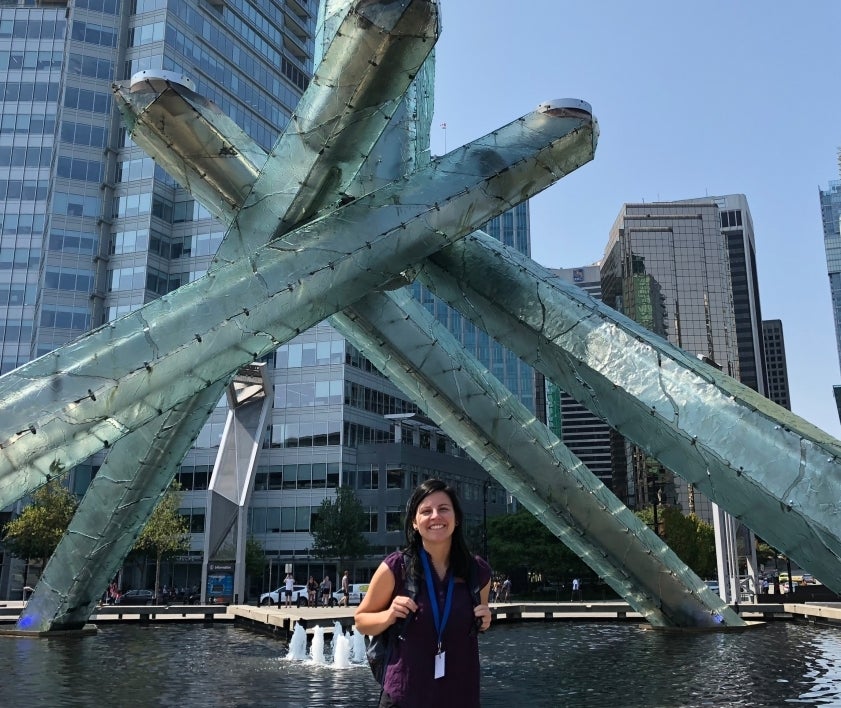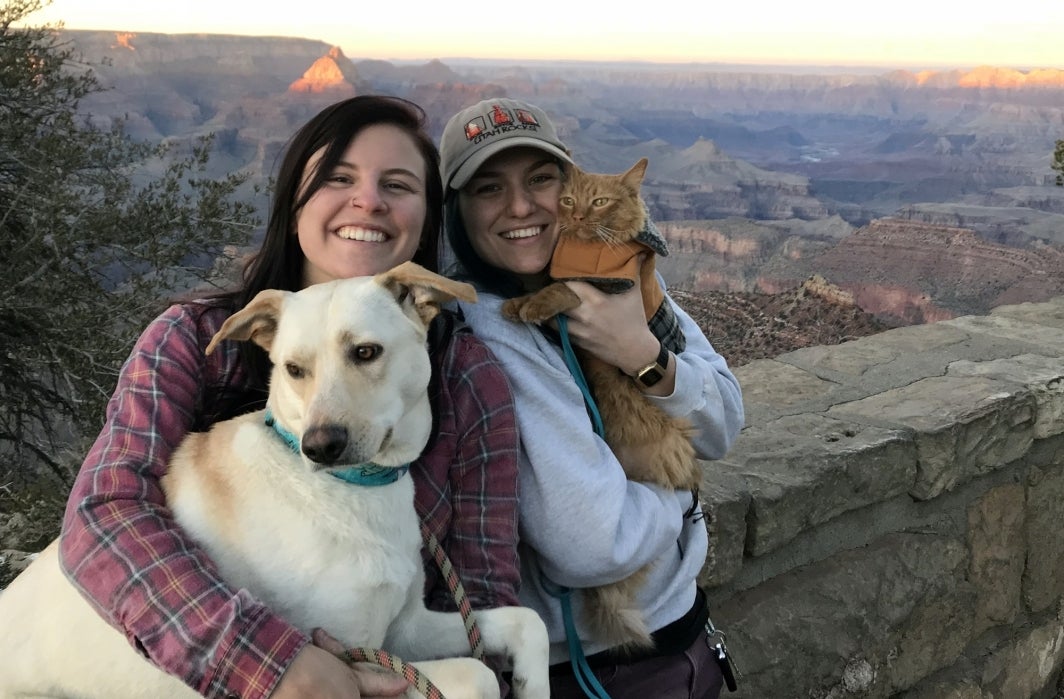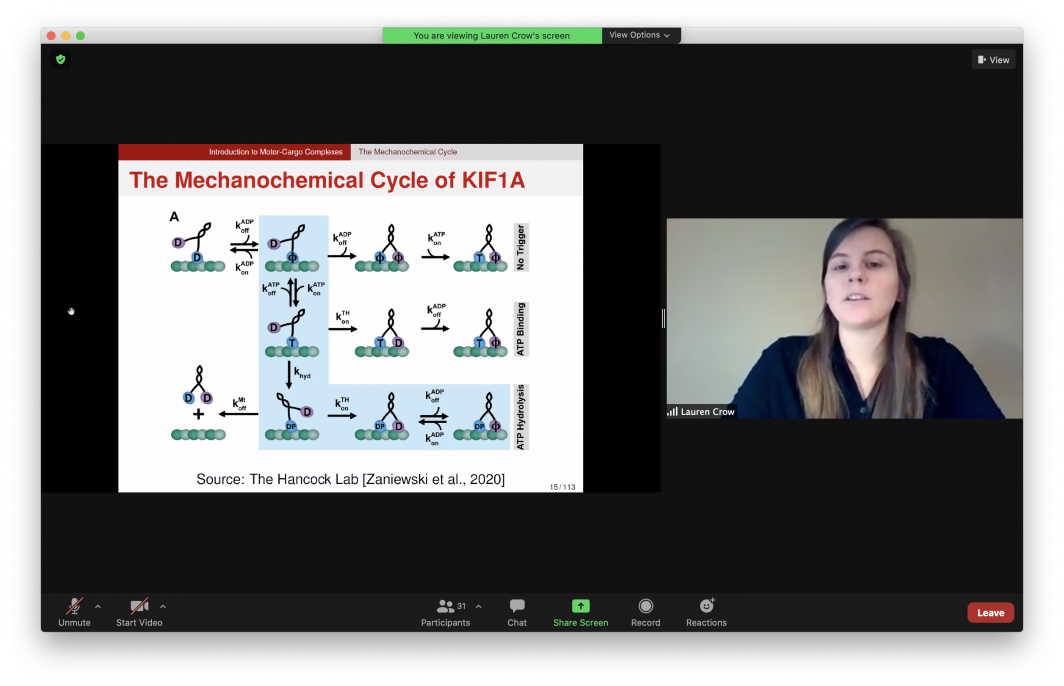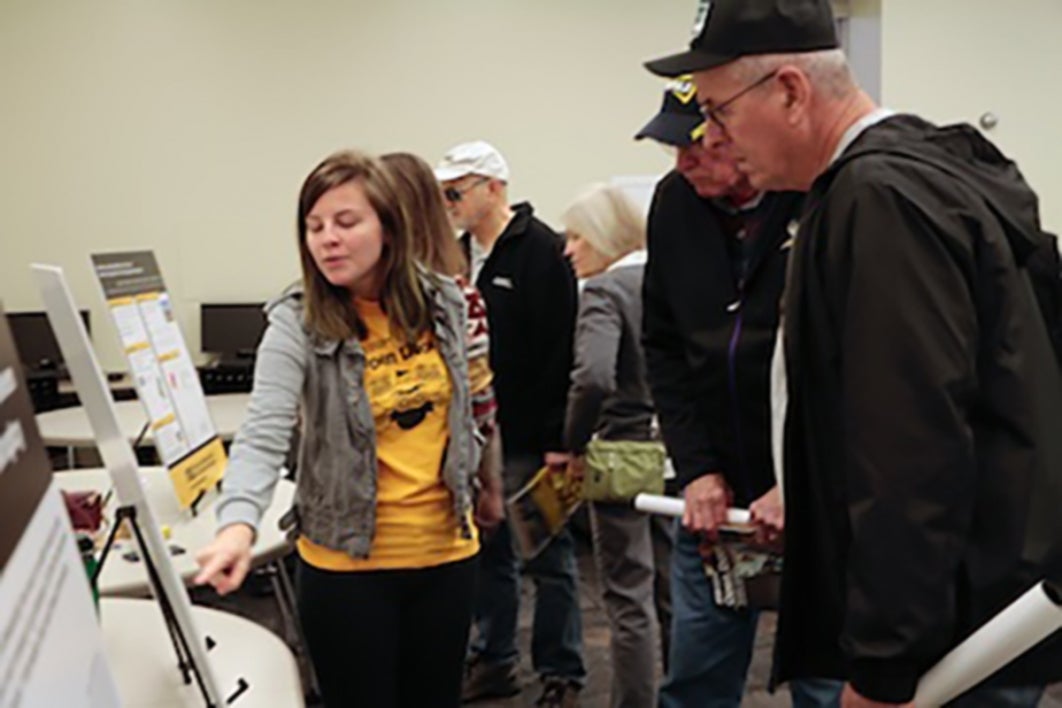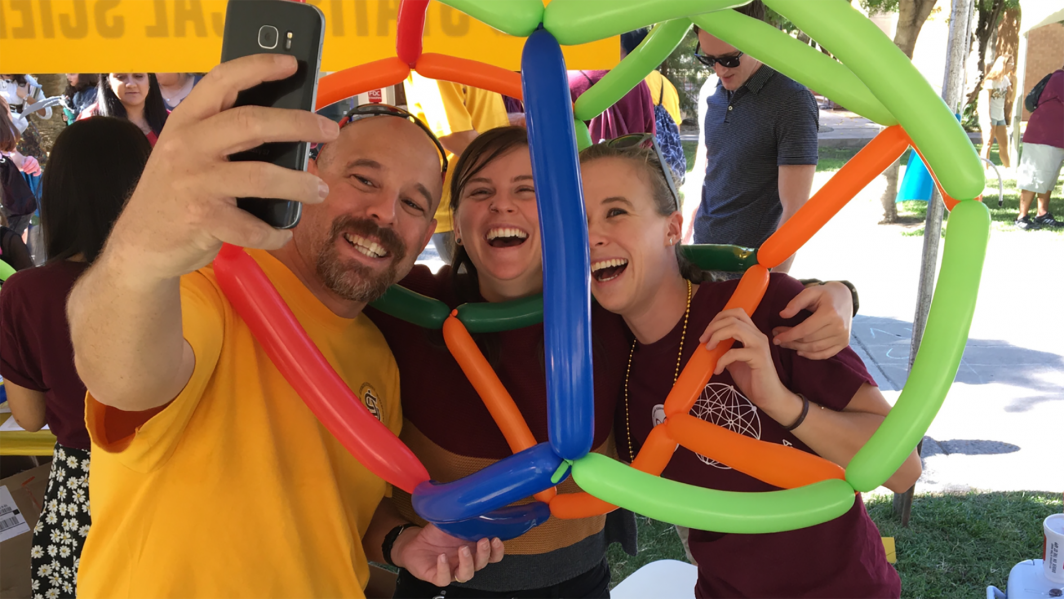Research Training Group Fellowship prepares stats PhD grad for ‘dream job’

Lauren Crow celebrates after completing her PhD in statistics.
Editor's note: This story is part of a series of profiles of notable spring 2021 graduates.
As early as eighth grade, Lauren Crow knew she wanted to pursue some kind of career related to math. In her junior year of high school, she took AP statistics, and that’s when she knew she would focus on statistics.
She grew up just outside of Richmond, Virginia. She loved school since kindergarten and was raised in a family where education was highly valued. Her mother is a pharmacist, her father is a chemist, and her brothers went to Virginia Tech and became engineers.
Crow earned a scholarship to Virginia Commonwealth University and loved her undergraduate experience in the mathematics department. She was a teaching assistant every year and enjoyed working with the students. For graduate school, she wanted to try something far from home and maybe travel out West.
When Crow visited the Tempe campus of Arizona State University, she fell in love with it. After the School of Mathematical and Statistical Sciences (SoMSS) offered her the Research Training Group (RTG) Fellowship, that sealed the deal, and she and her girlfriend moved to the Valley of the Sun.
The Research Training Group program at ASU was created to train future mathematicians and statisticians in the methodologies of tackling “big data” problems as they have emerged in recent decades. Extracting useful information from the ever-growing oceans of raw data can be challenging, and mathematical and statistical reasoning are central to addressing these challenges.
Sponsored by the National Science Foundation, the ASU RTG program provides training in three areas: statistics, computational mathematics, and harmonic analysis. The ASU RTG program fosters integration across these areas to cultivate mathematical scientists who have skills in all three of them and can understand how to draw on concepts from multiple areas in addressing data-oriented problems.
“I love how math and data are a part of everything,” said Crow. “In my research, we use stochastic differential equations to better understand why patients suffer from Alzheimer’s. I find it fascinating how math can be used as a tool in endless areas.”
Crow studies the movement of motor proteins inside cells. The cells transition between different types of motion while they move. Her challenge was to determine the best equations to describe the motion and implement them to describe the dynamics of different particles.
To visualize this problem, Crow describes a scenario. Imagine a raft floating in the middle of a lake, trying to travel from one dock to another dock. Attached to the raft is a giant glow-in-the-dark balloon. Looking down from high above at night, all that can be seen in the dark is the glow-in-the-dark balloon. There is no visible evidence of where the docks are, or the start or ending points. Crow tries to make inference on the raft and its movements just from the balloon signal.
The challenge is to figure out what the raft is doing as it’s traveling from one dock to the next, and mathematically Crow does this through an expectation maximization algorithm that involves a particle filter. She creates a model that describes the raft’s movement and tries to come up with the best match.
She takes the noisy signals from the balloon and tries to come up with the speed of the raft as it moves through different regimes. Sometimes the raft moves as if a person on the raft is paddling, or sometimes it behaves as if the person on the raft is tired and has the anchor out, or sometimes the raft has no anchor and is just floating around. She tries to determine the paddling speed, and how randomly the raft is moving when the anchors are in or out.
There are different types of motor proteins: Some go only in one direction, some go only in another direction, and then there are combinations. If she can tell what these proteins are doing, then she can tell when something is wrong. The earlier this is detected, the better the treatment for patients can be. Currently there is no cure for these neurodegenerative diseases, but the more that scientists can understand about the motor proteins transport systems, the closer they can get to figuring out how to prevent and treat them.
“Lauren’s interest and her later research included both modeling of biological systems (applied mathematics) and statistical inference,” said John Fricks, associate professor of statistics and Crow’s adviser. “The RTG emphasis at the intersection of these classical disciplines was an ideal training to prepare her for her doctoral research.”
“I think the RTG program totally changed the trajectory of my graduate school experience and took a whole year off of the time for me to graduate,” she said. “Instead of teaching my first year, I got to interact with professors more and start research early.”
During their first year in the RTG program, students work one-on-one with a professor of their choice on a project, write a paper and then present at the end of each semester.
“I did so poorly at those early presentations, but they were the biggest learning experiences,” said Crow. “It was so helpful to have feedback that early on. It made a huge impact on the rest of my career.”
Crow’s father, who had earned a PhD in chemistry, provided invaluable advice to her about navigating graduate school.
“Having my dad to call was a huge privilege. We would talk about specific issues I was having every week, and he would have excellent advice that was not obvious," said Crow. "He told me to not think of grad school as a competition, but to work with your classmates — not against them. Find your core group and help each other out. You’ll pull each other across the finish line every semester.”
Crow describes her first year as “a major challenge” and appreciated the collaborative atmosphere in the school.
“Specifically, Abby Nachtsheim (statistics PhD student) went above and beyond every time I needed help. Even after she graduated and had a full-time job, she would Zoom with me to practice talks and review my slides.”
During her RTG experience, Crow learned how to work independently, which significantly increased her skills as a researcher.
“I had a lot of time to improve my coding skills and apply it to all kinds of different data,” said Crow.” I also got to work with researchers in other fields related to my research, which was a great experience.”
“I very much enjoyed working with Lauren,” said Fricks. “She had a flexibility in approaching her work that is ideal for interdisciplinary research.”
Through the RTG program, Crow participated in an internship at Oak Ridge National Laboratory in Tennessee. She worked as a short-term research opportunity (ASTRO) intern creating a classification system to determine the shape of a neutron from neutron scattering data through functional data compression and Gaussian process regression. She worked in an office with six other interns where they were encouraged to interact with everyone outside their department. Every week there were multiple tours to see different parts of the lab. Crow met with Richard Archibald, senior scientist and ASU alumnus (Class of 2002), and got to see the high flux isotope reactor up close.
“It was massive! It was so cool to be able to see what was providing our data,” said Crow.
While living in Knoxville, which is close to the Great Smoky Mountains, she went trail running and hiking with the other interns. She enjoyed the experience and strongly encourages others who have the opportunity to intern at Oak Ridge.
Crow traveled to the Joint Statistics Meetings in Vancouver (2018) and Denver (2019), where she presented poster presentations on her research. Each year she and Fricks also traveled to Penn State University to visit the lab where they got the data for her dissertation. All the people involved with their grant would attend, including physicists from New York and mathematicians from Louisiana. They worked with all these people throughout the year, so it was important to have the annual in-person gathering to get everyone up to date. Crow got to practice giving talks about her research, which helped significantly with her prospectus and defense.
Back at ASU, she also participated in many of the outreach activities SoMSS promoted. Crow and a couple of her classmates created and ran an ASU Math Day workshop using catapults. Visiting high school students got to design and run experiments to understand the relationship between the catapult settings and the distance the projectiles traveled.
“I loved participating in all of the community engagement events that SoMSS hosted,” said Crow. “I got to work with students of all ages and help them see how awesome math can be, and it was always so fun.”
Crow is thankful for the many experiences in graduate school of presenting math to people who don’t understand math.
“The No. 1 selling point when I was applying to jobs was my ability to communicate difficult things to an audience that doesn't really know what I'm talking about,” said Crow.
“In grad school we got a lot of exposure to experts talking about their expert topic, and watching them made me really passionate about the accessibility of presenting math. Seeing seminars week after week of the different levels of people made me realize that you really need to focus on the audience. It helped me hone my skills at presenting, which I think is extremely important in industry.”
When asked to describe her “dream job,” Crow said she wanted a fast-paced job that allows her to work on different projects every day, and she wanted to help scientists in other disciplines understand how they can answer their questions through data.
Lauren Crow graduated this week with a PhD in statistics from the School of Mathematical and Statistical Sciences. She and her wife recently moved to Philadelphia to be closer to family.
Crow now works at WCG ACI Clinical as a biostatistican for data-monitoring committees in clinical trials.
“I'm so thankful that I had that opportunity be part of the RTG program at ASU. It was the best decision, and it's gotten me my dream job. My first job is my dream job — I couldn't have done that without my PhD. It’s crazy to think about, it all happened like I wanted it to.”
We asked Crow to share more about her ASU experience.
Question: What is something you learned while at ASU — in the classroom or otherwise — that surprised you or changed your perspective?
Answer: I learned how to approach a problem when I have no idea what to do. I overcame the tendency to give up and just search for the answer, and now I can sit down and attempt to think through what I know and see how that can apply to the problem.
Q: Which professor taught you the most important lesson while at ASU?
A: My adviser, Dr. John Fricks, unknowingly convinced me to not give up when I was struggling with qualifying exams.
Q: What is the best piece of advice you would give to those still in school?
A: Find your team. I wouldn’t have gotten through without the help of my classmates, and I know I helped them along the way as well. Focus on collaboration way more than competition.
Q: What was your favorite spot on campus, whether for studying, meeting friends or just thinking about life?
A: I enjoyed going for walks around campus, particularly down Palm Walk.
Q: What do you like to do in your spare time for fun?
A: I enjoy film photography and triathlons! I also like to go hiking with my cats.
Q: What do you think is most misunderstood about math by the general public?
A: I don’t think people realize that math is not as difficult as the world makes it out to be or how useful it can be. It is so helpful to use in everyday events.
Q: If someone gave you $40 million to solve one problem on our planet, what would you tackle?
A: I would probably use it in my current research of understanding the causes behind motor-cargo transport breakdown in neurons, which occurs in patients suffering from neurodegenerative diseases.
More Science and technology

ASU water polo player defends the goal — and our data
Marie Rudasics is the last line of defense.Six players advance across the pool with a single objective in mind: making sure that…

Diagnosing data corruption
You are in your doctor’s office for your annual physical and you notice the change. This year, your doctor no longer has your…
Large-scale study reveals true impact of ASU VR lab on science education
Students at Arizona State University love the Dreamscape Learn virtual reality biology experiences, and the intense engagement it…




